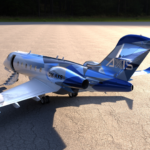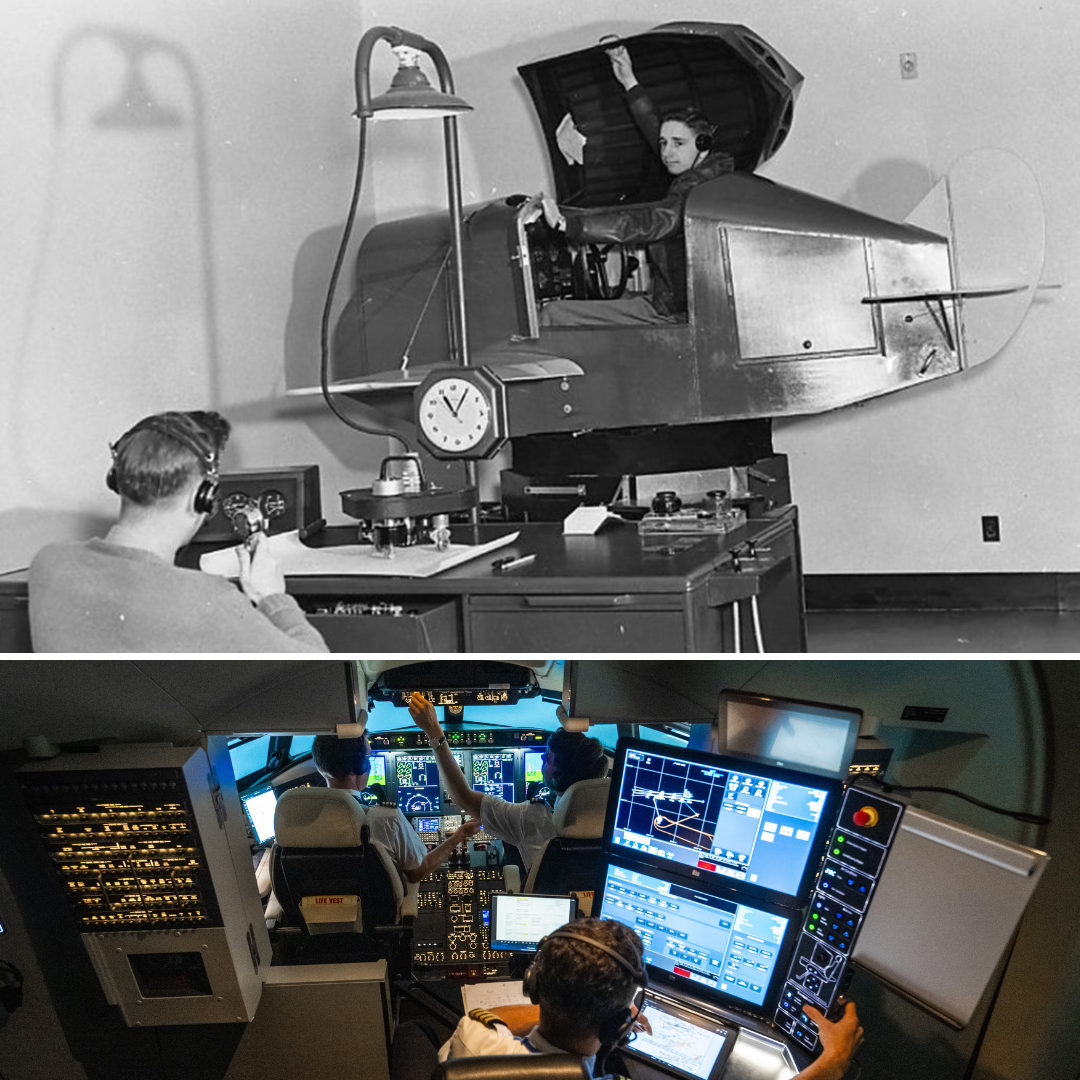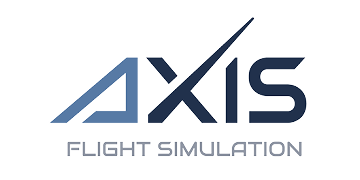
AXIS CERTIFIES ITS FIRST LEVEL-D ATR 72-600 FULL FLIGHT SIMULATOR IN USA
19. December 2023
EXPLORING THE FUTURE OF FLIGHT TRAINING WITH XR
29. February 2024
AXIS CERTIFIES ITS FIRST LEVEL-D ATR 72-600 FULL FLIGHT SIMULATOR IN USA
19. December 2023
EXPLORING THE FUTURE OF FLIGHT TRAINING WITH XR
29. February 202430. Januar 2024
The Evolution of Flight Simulation
According to a recent report by Expert Market Research, the flight simulator market is forecast to reach a value of USD 8.65 billion by 2032. Demand for new pilots and the need for efficient training solutions is expected to drive industry growth.
Recent technical advancements, such as the integration of AI, demonstrate how far flight simulators have come since their inception in 1929 when Edwin Link manufactured the world’s first flight training device – the “Blue Box”.
Almost 100 years later, let’s look back at the history of innovation, technological progress, and a commitment to flight training that has shaped today’s dynamic and growing sector.
1929: Inception of Flight Simulation - The Link Trainer
Edwin Link, an American inventor and entrepreneur, developed the world’s first flight training device shortly after the end of First World War. Widely known as the “Blue Box”, the groundbreaking Link Trainer was invented during a period of limited ground instruction to resolve safety drawbacks while training inflight.
Created using pneumatic technology to simulate the sensation of flying an aircraft, the Link Trainer featured a cockpit mounted on a series of pneumatic bellows that could simulate various flight conditions, including turns, climbs and descents. The device allowed pilots to practice instrument realistic flying and navigation, and laid the cornerstone for the future development of flight simulators.
After the critical 1934 Air Mail fiasco, when a group of ill-prepared US Army Corps faced 13 fatalities after experiencing severe winter weather conditions, the US Army adopted the Link Trainer as a crucial tool for training pilots in adverse conditions.
1939-1945: World War II and Military Training (1939-1945)
The tumultuous years of the Second World War ushered in a critical era for flight simulation. With an urgent need for trained pilots, military applications spurred the refinement and expansion of flight simulators.
These years marked the height of the Link Trainer's significance. More than 10,000 units were produced, becoming standard equipment in US flight schools, and trained an estimated 500,000 pilots. The Blue Box became an indispensable device that allowed pilots to refine their skills without the risks of inflight practice, simulating specific aircraft types and offering targeted training experiences.
1950-1960s: The Analog Era
Post-war, analog flight simulators were introduced during the 1950s. While the Link Trainer’s functions remained mechanical, analog instruments used basic electronics and hydraulics to enable more sophisticated motion systems and a broader range of scenarios, such as emergency procedures.
With the creation of Whirlwind, a groundbreaking computer system, the US Navy developed the Universal Digital Operational Flight Trainer which illustrated the value of digital computers within flight simulation. Whirlwind pioneered innovative technologies such as real-time processing, core memory and parallel processing, which were manipulated to fit the needs of flight simulator manufacturers.
Utilised by pilot training schools and the military, these devices propelled the flight training sector forward to embrace new technologies.
1970s: The Digital Revolution
The world experienced a digital revolution in the 1970s, with the invention of the first mobile phone, home computer and the progression of the internet. Extending to the flight training sector, the advent of computers allowed for more accurate and dynamic simulations of aircraft behaviour and instrument panels.
This shift from analog to digital laid the foundation for the transformative developments that would follow. Advances in the algorithms and electronics used in visual systems improved the fidelity of simulations and replicated complex real-world scenarios, contributing to a more comprehensive and effective training experience.
With the Concorde’s first flight in 1976, improvements in aviation technology became front page news, and the need to keep simulator technology in-line with innovative new aircraft became evident.
1980s: Hardware Advancements Accessibility
The availability of more powerful hardware, such as better computer processing and graphics capabilities, helped improve simulator performance.
The first version of the Microsoft Flight Simulator was released in November 1982, which began to bridge the gap between professional training tools and the growing community of passionate aviation hobbyists. Marketed to consumers as a video game, new versions have continued to be released, the latest model being Microsoft Flight Simulator 2024.
1990s: Graphics and Processing Innovation
The 1990s marked a turning point with substantial improvements in graphics and processing power. Simulators became more visually realistic, and the continued rise of PC-based flight simulations made the experience accessible to a broader audience of aviation enthusiasts.
The 1990s saw a transition from basic 2D to more advanced 3D graphics. This allowed for more impressive rendering of landscapes, aircraft and weather conditions. The introduction of texture mapping enhanced the realism of visual elements in the simulation, providing detailed and realistic textures to surfaces. Trainees could now experience convincing simulations of different terrains, weather conditions and potential emergencies, that would better prepare them for their careers as pilots.
2000s: Professional Flight Simulation
Advancements in the 2000s brought forward high-fidelity Full Flight Simulators (FFS) with lifelike cockpit replicas and advanced motion platforms. Widely adopted for professional pilot training by airlines and aviation organisations, these simulators became integral to the comprehensive training process.
The integration of realistic cockpit layouts and controls ensured that pilots transitioning from simulator training to real aircraft faced a seamless experience, reducing the learning curve and enhancing overall safety.
2010s: Virtual Reality Integration
The 2010s brought a new chapter in flight simulation with the integration of virtual reality (VR) technology. Adding a layer of immersion, VR headsets provided users with an even more authentic and captivating experience of virtual flight.
Pilots and enthusiasts could now step into a virtual cockpit, feeling a new level of connection with the simulated aircraft. VR enhanced the visual aspects of simulation and contributed to a more intuitive and engaging training environment.
2020s-present: Ongoing Technological Advances
As we step into the present, flight simulators continue to evolve. The 2020s have brought about advancements in artificial intelligence (AI), machine learning and real-time weather simulation. High-fidelity graphics, accurate physics modelling and global satellite data contribute to creating incredibly realistic and dynamic flight experiences.
Flight Simulation Today
The journey from Edward Link's pioneering efforts to the modern-day realism of flight simulators is a testament to innovation and resilience of our industry. At AXIS Flight Simulation, we take pride in our heritage and remain dedicated to staying ahead of the digital curve to provide cutting-edge flight training solutions for our customers.


